#ceramic pavilion
Explore tagged Tumblr posts
Video
Immaterial Architecture : Waverley Pavilion by Russell Moreton Via Flickr: russellmoreton.blogspot.com/ Building The Drawing. The drawing as analogue allows more subtle relations, of technique, material and process, to develop between drawing and building. Immaterial Architecture The Illegal Architect Jonathan Hill Oak Tree Oil Paper Plaster Rust Sgratfito Silence Sound Steel Television Weather Frosted Light Index of immaterial architectures TRANSPARENCY : LITERAL AND PHENOMENAL Colin Rowe, Robert Slutzky Interactions of the Abstract Body Josiah McElheny Object Lesson Interactive Abstract Body (Square) The Spatial Body (After Fontana) Tracing Eisenman Stan Allen Indexical Characters FABRIC=MASS+ FORM Alan Chandler The interest in fabric formwork is in its deployment in a building process, which is faster than conventional formwork. Fabric formwork is inherently more sustainable due to the minimising of both concrete and shuttering, and more radically, allows the constructor to intervene in the process of casting even as the cast is taking place. ANTI OBJECT Kengo Kuma We are composed of matter and live in the midst of matter. Our objective should not be to renounce matter, but to search for a form of matter other than objects. What that form is called- ARCHITECTURE, GARDENS< TECHNOLOGY is not important. ReThinking Matereriality The engagement of mind with the material world Elizabeth DeMarrais, Chris Gosden, Colin Renfrew The Affordances of Things Towards a Theory of Material Engagement Aesthetics, Intelligence and Emotions Relationality of Mind and Matter Material Agency Towards a Non-Anthropocentric Approach Carl Knappett, Lambros Malafouris At The Potter's Wheel : An Argument for Material Agency We should replace our view of cognition as residing inside the potter's head, with that of cognition enacted at the potter's wheel. The Neglected Networks of Material Agency : Artefacts, Pictures and Texts Material Agency as Cognitive Scaffolding The Cognitive Life of Things Material Engagement and the Extended Mind Lambros Malafouris, Colin Renfrew Minds, Things and Materiality Michael Wheeler Communities of Things and Objects : A Spatial Perspective Carl Knappett Imagining the Cognitive Life of Things Edwin Hutchins Things and Their Embodied Environments Architectures for Perception Structuring Perception through Material Artifacts Charles Goodwin Leach Pottery, Studio and Museum A Potter's Book Bernard Leach Adventures of the Fire, Vessels Through Time Ceramic Pavilion People make space, and space contains people Ceramic space and life Gordon Baldwin Objects For A Landscape David Whiting Vessels-Spaces that cannot be drawn, rather they need to be experienced. Imagining a Vessel in a Rock on a Beach, 2006,(charcoal on paper) The Architecture of The Ceramic Vessel The use of the vessel in the investigation of our world. The exploration through the dichotomy of the analysis between exterior and interior, of one pot to another and from the message they convey. MATERIAL MATTERS ARCHITECTURE AND MATERIAL PRACTICE Katie Lloyd Thomas PLENUMS : RETHINKING MATTER, GEOMETRY AND SUBJECTIVITY Peg Rawes ARCHITECTURE IN THE AGE OF DIVIDED REPRESENTATION The Question of Creativity in the Shadow of Production Dalibor Vesely The Nature of Communicative Space Creativity in the Shadow of Modern Technology The Rehabilitation of Fragment Towards a Poetics of Architecture The Projective Cast Architecture and its Three Geometries Robin Evans Architects do not produce geometry, they consume it Analysing ARCHITECTURE Simon Unwin Geometries of Being Architecture as Making Frames Space and Structure
#russell moreton#visual fine art#spatial practice#immaterial#architecture#drawing#collage#materials#building#Jonathan Hill#transparency#Colin Rowe#Josiah McElheny#Kengo Kuma#Alan Chandler#ReThinking Materiality#Colin Renfrew#Chris Gosden#Elizabeth DeMarrais#Peg Rawes#Carl Knappett#Lambros Malafouris#Edwin Hutchins#Charles Goodwin#Dalibor Vesely#Michael Wheeler#David Whiting#ceramic pavilion#Gordon Baldwin#Bernard Leach
1 note
·
View note
Text

Pavilion of Ceramics and Glasswork on the 1900 Paris World Exhibition
French vintage postcard
#old#postcard#postkaart#french#exhibition#vintage#briefkaart#postal#paris world exhibition#ansichtskarte#ephemera#pavilion#photography#glasswork#photo#ceramics#world#postkarte#tarjeta#historic#sepia#paris#pavilion of ceramics#carte postale
6 notes
·
View notes
Text
Amazing Three Story Wedding Cake Pavilion In Which You Can Marry Is Now Complete.
A little over a year ago we told you about the Waddeson Wedding Cake Pavilion project by artist Joana Vasconcelos and we expressed how we couldn’t wait to see it finished. Not only is the art installation completed but it’s more intricate, colorful and beautiful than we could have imagined! It now ranks up there with one of the coolest places to get hitched. Waddeson Wedding Cake Pavilion The…

View On WordPress
#buckinghamshire#ceramic wedding cake building#Joana Vasconcelos#Portuguese President Marcelo Rebelo de Sousa#The Rothschild Foundation#Waddeson Estate art#Waddeson Manor#Waddeson Wedding Cake Pavilion#wedding cake pavilion#wedding venue#where to get married
0 notes
Text
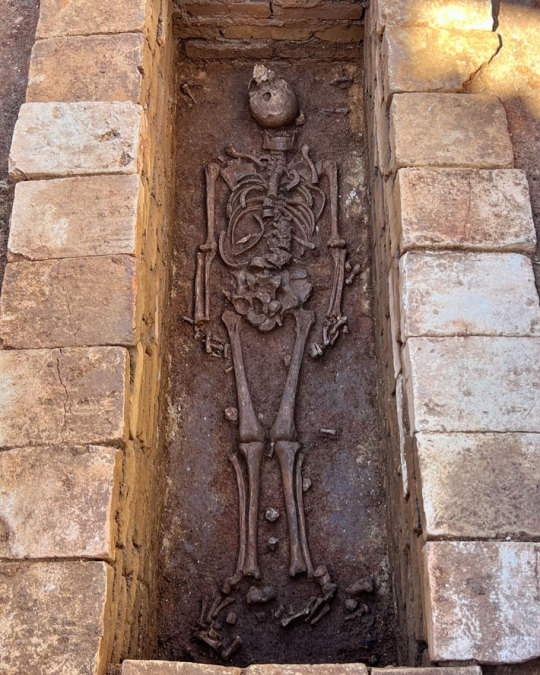
Three Roman Graves Uncovered in Portugal
Three burials dating to the 5th or 6th century AD have been unearthed in the ancient Roman city of Ossónoba in Faro, southern Portugal.
The Ossónoba’s first archaeological evidence dates back to the 4th century B.C., when the Phoenicians settled in the Western Mediterranean. The city was then called Ossónoba From the 2nd century B.C. until the 8th A.D. the city was under Roman and Visigoth dominance being afterwards conquered by the Muslims in 713.
A team of archaeologists from ERA Arqueologia discovered ancient Roman structures and the remains of a man, woman, and child while conducting excavations over a 5,000 square meter area that will eventually house a real estate development.
The excavations, which took place before a construction project, revealed the grave of a man whose skeleton was complete and who would have been between 39 and 45 years old, as well as a young woman under the age of 25, and a baby who would have been no more than six months old, according to archaeologist Francisco Correa.
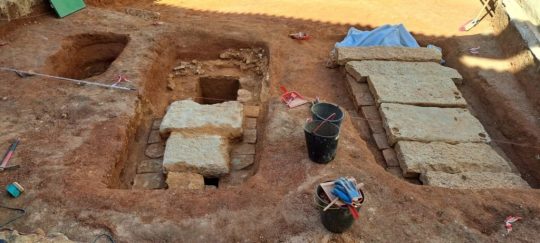


Francisco Correia, the project’s head archaeologist, said in a statement that the discoveries were made in an old truck repair workshop and are believed to date from the 5th or 6th century.
The tombs appear to have been looted in the past to steal “small bracelets, necklaces, and rings,” according to anthropologist Cláudia Maio. The tombs indicate that the people may have had “some economic status” as they were not simply placed in open graves but instead buried in carefully built graves.
The proximity of the three people’s graves seems to indicate that they were family members, though the team cannot be certain of that. “But we cannot say anything for sure,” the anthropologist said.
To learn more, the researchers hope to be able to provide more precise answers through DNA tests and isotopic analysis techniques used to determine population movements and dietary habits from chemical traces in ancient human remains.
This latest archaeological discovery did not come as a surprise to archaeologists, who had already led similar works which resulted in the discovery of a Roman game artifact believed to date back to the first century AD in 2020.
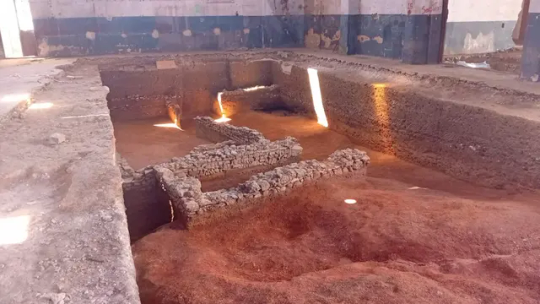
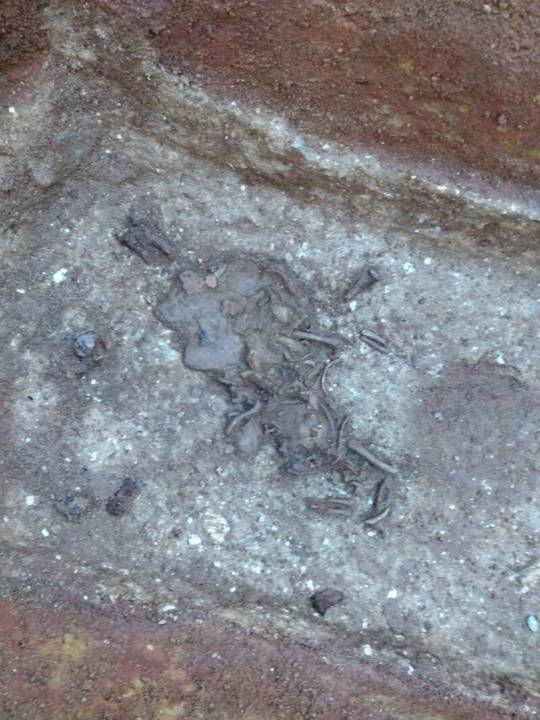

“We know that we are in an area with archaeological potential where there is a 17th-century convent (of Santo António dos Capuchos) to the west, and to the east lies the area where the mosaic of the Ocean God (Deus Oceano), now a national treasure, was found,” he said.
What did come as a surprise to archaeologists was the location of the tombs.
“Based on previous studies, this would have been an area that was possibly residential or more linked to industrial activities. There are many traces of salterns. Largo da Madalena would have been the entrance to the urban area of the city of Ossónoba. The identified graves are in the Figuras area, near Teatro Lethes, close to the Ermida de São Sebastião and the Pavilion of Escola D. Afonso III. This area is almost within the urban fabric,” the archaeologist explained, adding that this illustrates both the “growth and decline of Ossónoba.”
The graves of the man and the woman “were sealed with limestone slabs,” believed to be reused parts from “some of the most emblematic buildings that would have been here in the area,” he believes.
According to the project manager of ERA Arqueologia, who was co-responsible for the work, in addition to the graves, hundreds of small pieces were also discovered which suggest that there may also have been a mosaic there.
The researchers also recovered Roman artifacts in the area, including ceramics, bone dice, nails, pins, a spoon, possible evidence of a dye factory, and coins minted during the reign of Constantine the Great, between A.D. 306 and 337.
Cover Photo: Roman mosaic of the god Oceanus, part of the ancient city of Ossónoba, the modern town of Faro, in Portugal.
By Leman Altuntaş.
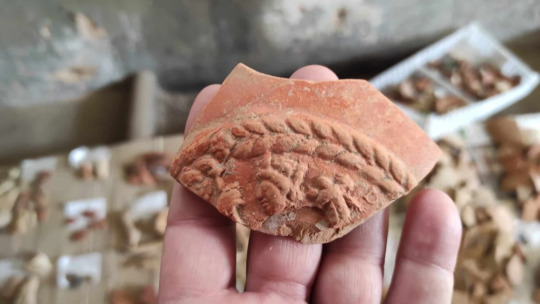
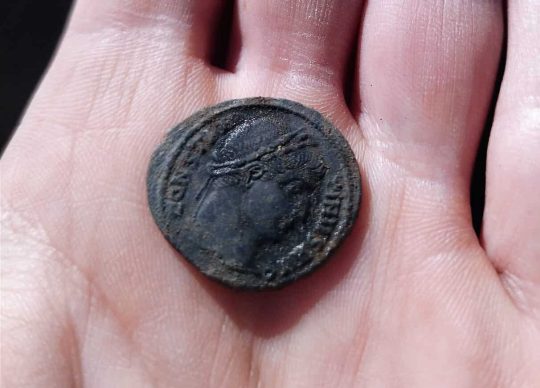
#Three Roman Graves Uncovered in Portugal#Roman city of Ossónoba in Faro#ancient grave#ancient tomb#ancient artifacts#archeology#archeolgst#history#history news#ancient history#ancient culture#ancient civilizations#roman history#roman empire#roman art
256 notes
·
View notes
Text
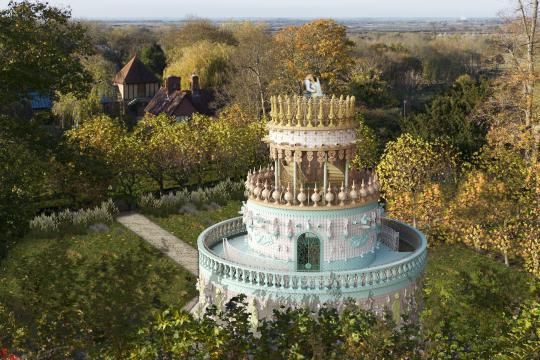
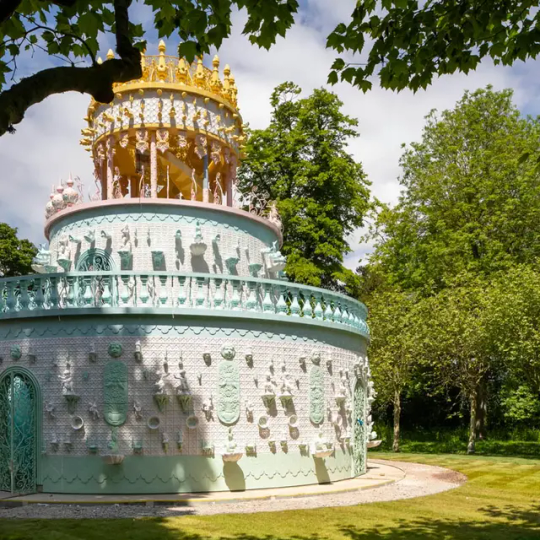
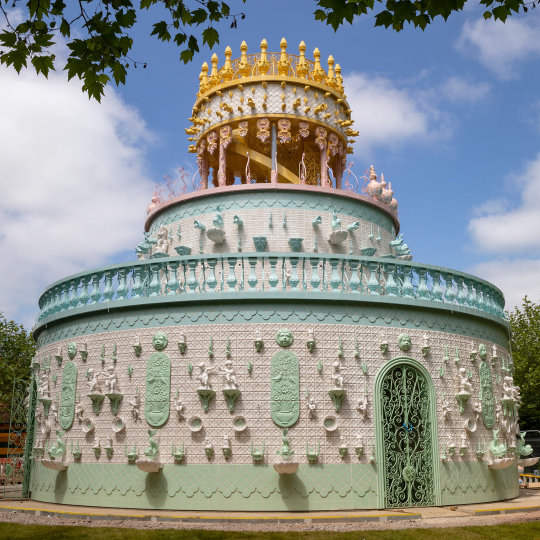
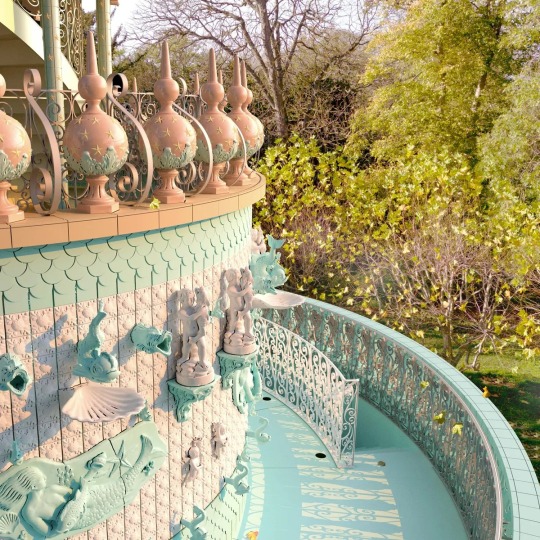
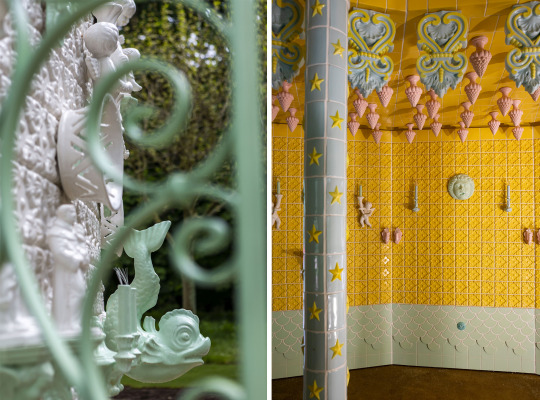

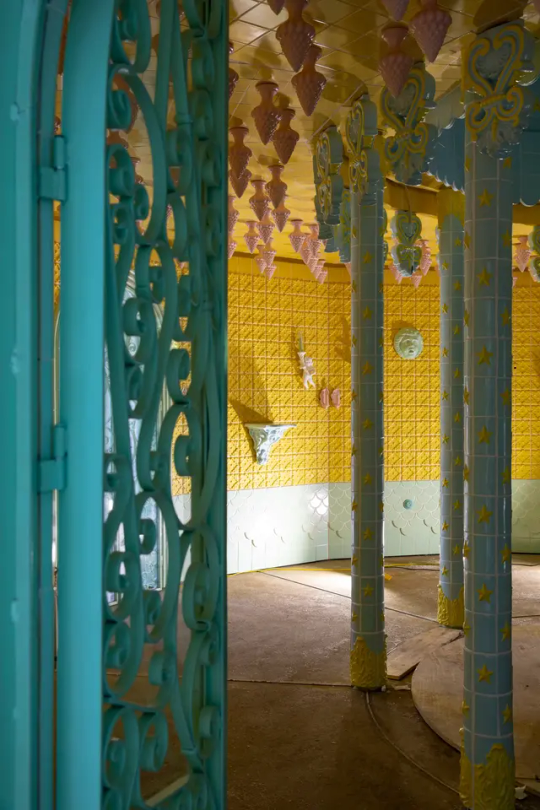

“Wedding Cake” Pavilion, Waddesdon Manor, Aylesbury, Buckinghamshire, United Kingdom,
Commissioned by the Rothschild Foundation, the three-layered cake is clad entirely in ornate ceramic tiles, a craft tradition rooted in Joana Vasconcelos’ home in Lisbon.
Pâtisserie-worthy adornments like fish diving into shell bowls and corniced platforms complement lacy ironwork and pastel hues.
Part sculpture and part building, the immersive installation invites visitors to walk up winding inner stairwells and traipse around the tiers.
Courtesy: Joana Vasconcelos
#art#design#architecture#history#style#castle#luxurylifestyle#pavillion#cake wedding cake#folie#ceramics#waddesdon manor#aylesbury#united kingdom#luxuryhouses#luxury homes#joana vasconcelos#dolphin#cherub#faux icing#patisserie
1K notes
·
View notes
Text
Wistful Moon - Changting Pavilion
Jingyuan x Reader
We all have to leave one day, he just hopes it won't be too soon
//This wasn't meant to make me cry, why did I cry writing this. This is probably all over the place. Poem is 离思 by 元稹.

曾 经 沧 海 难 为 水, 除 却 巫 山 不 是 云
✦ . ⁺ . ✦ . ⁺ . ✦
For you to so freely partake in drink should have tipped Jingyuan off to your emotional state much earlier than it did. Albeit, when you were under such lovely lighting and garbed in attire he could only, pathetically, describe as undoubtedly becoming, he found it hard to think of little else, caught up in the sight of your very being.
Your fingers wrapped around your cup of wine, curling into cold ceramic and bringing it to your painted lips, soft and inviting. His eyes keenly follow along the movement, watches your throat bob as you swallow, how when you lower your cup, a bright smile pulls across your face in response to something someone said. He does not think there is anything more beautiful than that smile, and though you have always told him you hated how wide it is, how you keep smiling with too much teeth and how it always happens when you least like it to, Jingyuan adores that smile of yours. It is yours, so wonderfully yours and so wonderfully a symbol of your unadulterated joy. And whenever he sees even the slightest hint of it, that flush that always threatens to expose him starts to tinge his cheeks.
You turn briefly to take a glance at him, that smile of yours still on your lips and he feels it once more. If only for a moment, you turn away and he does not know whether to thank or curse the aeons for having that sight so fleetingly.
Another refill of your cup, you drink once more, then another refill. You have come to your fourth cup since the wine has been served, and he worries that at this rate, you will be passed out drunk before the event ends. Jingyuan moves to take your cup away from you, something you respond with a non-committal glare before you slump by his side. Resting your head against his shoulder, he watches your eyes scan the room absentmindedly, as though looking for something, someone.
It is when his lieutenant returns to your side that he properly comes to the revelation of your drinking. He had just received his military commission, and for someone such as you who has spent the past few years practically raising him as your own, this was a far earlier call than most parental figures experience. The sudden realisation that one day, you may no longer see him at the breakfast table with his horrid bed hair, no longer have him begging for food and pocket change, they surely were not thoughts anyone would like to have so soon (he is not sure whether it is just you feeling as so).
Your eyes seem to focus on the child’s presence, waving him over as a milder smile now decorated your lips. Yanqing comes to your side, and in a move he clearly did not expect, you wrap an arm around him to pull him close to you, his standing form pressed against your seated one.
“Qing’er, you’re so big…” You sigh, speech just the slightest melancholic. Reminiscing of days long gone, he thinks he can catch the hint of tears welling at your eyes. “I remember when you were still so small, you always loved it when I would carry you around.”
Yanqing’s cheeks flush at this comment, especially in public, and he splutters to retort back, to say something to brush past the sappy notion. Still, you do not let that stop you, turning your gaze to face him entirely as you hum, “I’m so proud of you, y’know that?”
He only nods, and though it is clear he does not quite know how to respond to your sentiments, he lets you hold him just a little longer, his hand on yours.
Jingyuan watches on, the quiet moment enhanced by the fact that with so many eyes looking away, the two of you had only looked all the more poignant. He wonders how long this has been weighing on your mind, how much it ached you to keep it inside in fear of the child’s reaction. And though he would love for nothing more than to comfort you, what you needed was not him but to reaffirm Yanqing’s presence.
It is not long until the festivities die down and the two of you are left with only each other as company. Now certainly allowed more freedom than before, you lay in his embrace, his arms wrapped around you as the Luofu’s simulated moon hangs high in the sky.
“He’s so big now,” Your voice is hushed, barely a whisper and seemingly meant for only your ears.
“That he is,” He hums, feeling your fingers play with his hand as though distracting yourself from speaking more. A soft, practically inaudible breath escapes him, his eyes remain on you as he murmurs, “My love, what has gotten you so sentimental?”
There is no response out of you for a moment, merely the sound of your breathing, just the slightest laboured and all too preoccupied with keeping your emotions under lock and key. Yet when he meets your eyes, the dewlets clinging to your lashes and the strained quality of your voice only tortures that heart of his that so ardently belongs to you.
“I hate thinking about the day you’re no longer with us, or I’m no longer with you two.”
How can he bear to think of such a future as well? Though the two of you are more than aware that it may one day come (after all, neither of you are green in your years), it has been a thought he pushes away every time it surfaces. He has plans for if he is to become mara-struck, plans for if he goes peacefully, but for you, it is different. He would have to strike you down should the former occur, but he does not know whether he would be able to live with it.
So he pretends it will not happen. He pretends that the two of you have all the time in this world, all the time to watch the moon and lay together side by side.
All the time in the world for him to memorise your face so that if one day it should really happen, he may be reminded of the joy you brought him, and not the grief your passing will cause.
“All the better for us to spend what time we have together,” Jingyuan mutters, pulling you closer to him as he nuzzles against you.
You sniff, that smile of yours, bittersweet but still, always, so beautiful presents itself to this world. Your eyes flutter open and close, and eventually he is left with nothing but the slow rise and descent of your chest, soft breathing his lullaby for the night. He traces along the curve of your jaw, the wrinkles of your lips, the marks upon your face, everything that made you.
You are still clinging to him, so tightly it was almost as though you were afraid that he would leave when your eyes opened in the morning. He does not blame you.
Looking to the moon, he prays, the first time he has done so sincerely, so desperately, that the three of you will not be ripped apart so soon, that at the very least, make it so that he will be the last to go once more.
✦ . ⁺ . ✦ . ⁺ . ✦
取次 花 丛 懒 回 顾, 半 缘 修 道 半 缘 君
62 notes
·
View notes
Text
New Chapter - Mother's Day
“You know, I’m not sure what I expected, but it wasn’t this,” I said, shooting Jason a wry smile.
He’d taken us to the mainland, to the fancy stretch of Gotham where the truly elite have their fancy sprawling manors. We were at an estate that one of Jason’s brothers apparently owned, out on the grounds in a dirt field, standing under a well lit metal pavilion.
There were tables covered in breakable objects, some that looked ridiculously expensive, others that were from the dollar store. Off to the side of the pavilion were various pieces of furniture and an old beat up car, all lit up with floodlights that made it nearly bought as day. To the other side there was an area paved with asphalt that had a large concrete wall in the center, lit up with more floodlights.
The table next to me held some safety gear, several gallons of paint, a box of what looked like spray paint, a few baseball bats, some metal rods, a blow torch, and a crowbar with a pink bow stuck on it. Jason had rolled his eyes at that last one.
“Best therapy there is,” he said, grinning, “First, you break shit until you break down or until the feelings aren't so loud. Then, you make some art.”
“That ‘you’ had better be a ‘we’,” I said, inspecting the bats.
“Oh absolutely,” he agreed, picking up one of the metal rods and twirling it like a baton, “Breaking shit is what I’m best at.”
I didn't agree, but I didn't have the energy to argue the point. Opting for one of the metal rods, I let him take the lead, following him to one of the tables of breakable objects. He set down his rod and pulled a cardboard box out from under the table.
“Alright, load this up with anything that looks like it might be fun to break,” he said, getting to work adding things in.
I picked at random, avoiding anything that looked too expensive. If it was here I was sure that it was probably okay to break, but the idea of destroying something worth more than one of my paychecks felt weird. When the box was full, he carried it over to the wall and set it at the far edge of the asphalt, next to a pedestal.
Jason pulled a fancy vase out and set it on top of the pedestal, “Now there’s obviously no rules on how to break the shit. Steph likes to chuck it at the wall. Personally, I prefer this.”
He took a swing at the vase, shattering it, sending shards flying in the direction of the wall. I felt a strange sort of anticipation as he gestured for me to take my turn. I dug out a ceramic statue of what was probably supposed to be a mom and daughter hugging and set it where the vase had been.
“Here goes nothing,” I said, taking a deep breath.
The moment the rod made contact I felt the same rush that I’d felt that night at the cabin, when I’d made a bullseye with my first arrow. It was incredible, the sense of freedom and power the action gave. The dissociative fog that had settled over me was still there, but as ceramic shards went flying I felt a hint of something that wasn’t just the pain I’d expected. Something almost like anger.
“Better than state therapy?” he asked, his voice light and teasing.
“Hell yes.”
#dc comic fanfics#ao3 fanfic#jason todd#dc comics#red hood#original female character#referenced trauma#referenced child abuse#referenced addiction#referenced abuse#batfam#stephanie brown mention#of course steph jokes about the crowbar#it's a dead robins club thing#so here's the thing#have ya'll read the comic version of how jason todd died?#it's super fucked#sheila haywood is the actual worst#catherine todd wasn't much better#jason todd deserves happiness#therapy#ptsd#art therapy#breaking shit is also therapy#death in the family
6 notes
·
View notes
Text
Tropical Poolside Pavilion Bedroom

Traditional Balinese pavilion with intricate carvings, terracotta roof tiles, poolside setting, lush green foliage, exotic resort ambiance. Follow Ceramic City on Tumblr Source: https://soudasouda.tumblr.com/post/750207642804371456/tropical-poolside-pavilion-bedroom-follow-souda-on
#modern#design#product design#home#decor#decoration#home decor#home design#interiors#interior design#living room#bedroom#kitchen#buildings#architecture#furniture#furniture design#industrial design#minimalism#minimal#living rooms#lighting design#lights#bathroom
13 notes
·
View notes
Text
There is something to be said about the arbitrary distinction between "real art" and "theme park art". Where the concept of art being commissioned for a commercial venue like a theme park is thought to rob it of all artistic value. So things like Mary Blair's giant ceramic murals aren't considered art and can be callously destroyed to make room for other stuff with little fanfare. Or things like Omega Mart, which is functionally a bunch of art exhibits stuck together by an ARG, but because it costs money? (So do museums?) Or because it's just too fun and silly? It's deemed too commercial and more of a theme park than an immersive art exhibit. Or things like Dismaland, which seemed designed to directly challenge the distinction between theme parks and art. What makes Dismaland different from Omega Mart? And what makes Omega Mart different from an Epcot Future World pavilion?
6 notes
·
View notes
Text
📍Hong Kong Palace Museum
Gallery 1: Entering the Forbidden City: Architecture, Collection, and Heritage
P1: Bell (bó zhōng) with stand--"Nán lǚ" pitch
Qing dynasty, Qianlong period, 1761
Bell: gilded copper alloy; stand: lacquer and gold on wood
P2: Chime (tè qìng) with stand--"Huáng zhōng" pitch
Qing dynasty, Qianlong period, 1761
Chime: jade (nephrite), gold; stand: lacquer and gold on wood
Gallery 2: From Dawn to Dusk: Life and Art in the Forbidden City
P3: Table screen with drawers for storing the Bight Pillars of the Orchid Pavilion
Qianlong period (1736~1795)
Zǐtán wood
Gallery 3: Brilliance: Ming Dynasty Ceramic Treasures from the Palace Museum, 1368~1644
P4: Architectural fitting in the shape of a dragon
Ming dynasty (1368~1644)
Earthenware with glazes
Gallery 4: The Hong Kong Jockey Club Series: Stories Untold - Figure Paintings of the Ming Dynasty from the Palace Museum
P5: Portrait of Táo Yuānmíng
Wáng Zhòngyù (active late 14th century)
Ming dynasty, late 14th century
Hanging scroll, ink on paper
Gallery 5: The Quest for Originality: Contemporary Design and Traditional Craft in Dialogue
P6:
1.(lower): Duck-shaped incense burner
Han dynasty (206 BCE~220 CE)
Bronze
2a.(left): Water dropper in the shape of a mythical beast
Qing dynasty (1644~1911)
Bronze with gold and silver inlay
2b.(right): Water dropper in the shape of a mythical beast
Ming dynasty (1368~1644)
Jade (nephrite)
3.(upper): Ram-shaped lamp
Han dynasty (206 BCE~220 CE)
Bronze
P7: Vase with spiral pattern
Imperial Workshops
Qing dynasty, Qianlong mark and period (1736~1795)
Blown glass
Gallery 6: Passion for Collecting: Founding Donations to the Hong Kong Palace Museum
P8: Headdress with phoenixes chasing a pearl
Liao dynasty (907~1125)
Gilt copper
Gift of Mengdiexuan Collection (Ms. Betty Lo Yan-yan and Mr. Kenneth Chu Wai-kee)
Gallery 7: The Hong Kong Jockey Club Series: Dwelling in Tranquillity - Reinventing Traditional Gardens
P9: Sky, Water and Land
Keith Lam
Generative visual and sound dataset, LED screen, stainless steel, bronze, four-channel audio installation
"In spring's serene embrace, tranquil water flows with grace; sky, water, and land above and below, boundless expanse azure aglow." -- Fan Zhongyan (989~1052), Yueyang Pavilion, Song dynasty
This artwork is inspired by the pavilions in Chinese gardens.
Gallery 8: Bank of China (Hong Kong) Presents: The Origins of Chinese Civilisation
P10: Relief with tigers and a human face
Shimao culture (4300~3800 BP)
Stone
📍香港故宮文化博物館
展廳1:紫禁萬象——建築、典藏與文化傳承
P1:甬紐橋口鎛鐘——南呂律(附架座)
清乾隆二十六年(1761年)
鎛鐘:銅鍍金;架座:木胎、金漆
P2:雲龍紋特磬——黃鐘律(附架座)
清乾隆二十六年(1761年)
特磬:碧玉描金;架座:木胎、金漆
展廳2:紫禁一日——清代宮廷生活與藝術
P3:蘭亭八柱八屜插屏
清乾隆(1736~1795年)
紫檀木
展廳3:流光彰色——故宮博物院藏明代陶瓷珍品
P4:琉璃龍吻
明(1368~1644年)
陶
展廳4:香港賽馬會呈獻系列:故事新說——故宮博物院藏明代人物畫名品
P5:陶淵明像
明,十四世紀晚期,王仲玉(活躍於14世紀晚期)
紙本墨筆立軸
展廳5:器惟求新——當代設計對話古代工藝
P6:
1.(下)鴨式薰爐
漢(公元前206~公元220年)
青銅
2a.(左)異獸形硯滴
清(1644~1911年)
銅胎錯金銀
2b.(右)瑞獸形硯滴
明(1368~1644年)
青玉
3.(上)羊式燭臺
漢(公元前206~公元220年)
青銅
P7:乾隆款纏絲玻璃撇口瓶
清乾隆(1736~1795年),清宮內務府造辦處
玻璃
展廳6:樂藏與共——香港故宮文化博物館首批受贈藏品展
P8:雙鳳戲珠紋冠
遼(907~1125年)
紅銅鎏金
夢蝶軒主人(盧茵茵女士和朱偉基先生)捐贈
展廳7:香港賽馬會呈獻系列:山林市城——遊歷舊園新景
P9:一碧萬頃
林欣傑,生成式視覺與音效數據組、LED屏幕、不鏽鋼、銅、四聲道聲音裝置。
「至若春和景明,波瀾不驚,上下天光,一碧萬頃」。
——宋•范仲淹(989~1052年)《岳陽樓記》
創作靈感源自中國園林建築中的「亭」。
展廳8:中國銀行(香港)呈獻:中華文明溯源(2024年9月25日~2025年2月7日)
P10:神人對虎紋石雕
石峁文化(距今4300~3800年)
石










4 notes
·
View notes
Text

A 1929 architectural drawing showing details of tile wainscot for the bathing pavilion patio, Agua Caliente. Faded text reads, “Detail showing treatment of tile wainscot – bathing pavilion patio. Agua Caliente - Wayne D. McAllister architect. Tile by Gladding, McBean & Co. 3-4-29. Scale ¾ inch =1 foot.” Gladding, McBean & Co. is one of the oldest companies in California, a pioneer in ceramics. The company dominated the industry in California during the heyday of architectural terra cotta, between approximately the 1880s to the 1930s. The California State Library holds Gladding, McBean & Co.’s project files from 1888 to 1966, which include plans for decorating thousands of buildings.
20 notes
·
View notes
Text
A 7-Day Journey through Suzhou, Hangzhou, and Shanghai
Itinerary Overview
• Day 1-2: Suzhou
• Day 3-4: Hangzhou
• Day 5-7: Shanghai
Day 1-2: Suzhou – Classical Gardens and Water Town Charm
• Humble Administrator’s Garden: Explore this serene garden and enjoy traditional snacks at nearby tea houses. Suzhou-style desserts like osmanthus cakes and plum cakes pair well with green tea. This iconic garden, known for its poetic design and meticulous layout, is the largest in Suzhou and features classic Jiangnan landscaping. Stroll through pavilions, ponds, and stone bridges surrounded by lush greenery, giving you a sense of traditional Chinese aesthetics and harmony with nature.

• Suzhou Museum: Beyond its unique architectural design by I. M. Pei, the museum houses ancient artifacts, ceramics, calligraphy, and paintings that showcase Suzhou’s rich history and culture. Each exhibit tells a story of China’s artistic heritage, making it a must-visit for history lovers. After exploring the exhibits, head to the nearby area to try Suzhou-style mooncakes, a savory treat with pork filling.

• Pingjiang Road: This ancient canal-side street exudes old Suzhou charm, with well-preserved architecture, traditional teahouses, and local shops. You can try Suzhou-style pastries like plum cake or enjoy the scenery along the canal, where boats quietly glide by. This ancient street is packed with food stalls selling Suzhou’s famous crab roe soup dumplings and pan-fried dumplings.

• Tongli Ancient Town: A quintessential Jiangnan water town, Tongli offers winding canals, ancient stone bridges, and traditional Ming and Qing dynasty residences. Highlights include the Retreat & Reflection Garden, a UNESCO World Heritage site, where you can experience serene classical architecture and landscaping. Beyond its picturesque canals, Tongli offers Jiangnan classics like sweet and sour Mandarin fish and braised pork belly served in quaint riverside restaurants.

Day 3-4: Hangzhou – Natural Scenery and Cultural Heritage
• West Lake Boat Tour: Take a leisurely boat ride to appreciate the lake’s famous sites, like Leifeng Pagoda, which is linked to romantic Chinese legends, and Three Pools Mirroring the Moon, where floating pagodas create a mesmerizing reflection. West Lake is known for its idyllic beauty, with willow-lined shores, lotus ponds, and distant mountains. After a boat ride, enjoy a lakeside meal with Hangzhou specialties like Dongpo pork (a tender, slow-braised pork belly named after poet Su Dongpo) and West Lake Vinegar Fish, a sweet and tangy fish dish often made with carp from the lake.

• Lingyin Temple: This sacred Buddhist site, surrounded by lush forests and rocky outcroppings, is one of the oldest and most significant temples in China. As you explore the temple, admire the intricate Buddhist carvings on Feilai Peak and immerse yourself in the tranquil atmosphere. Set in lush forested hills, this ancient Buddhist temple is both a place of worship and a scenic retreat. Nearby, sample vegetarian temple dishes such as Buddha’s Delight with tofu and bamboo shoots.

• Longjing Tea Plantation: Visit the tranquil tea fields of Longjing Village, where China’s famed Dragon Well tea is produced. Participate in a tea-picking experience, learn about the tea-making process, and sample the fresh green tea, renowned for its delicate aroma and refreshing taste. Visit Dragon Well’s tea fields to experience tea-picking and sample Longjing shrimp, a light dish flavored with tea leaves, at a local restaurant overlooking the fields.

Day 5-7: Shanghai – Modern Metropolis and Cultural Fusion
• The Bund: Stroll along the Bund’s waterfront for views of Shanghai’s historic colonial buildings and modern skyline. Dine at a nearby restaurant and try Shanghai-style braised pork (hong shao rou), paired with steamed buns.

• Yu Garden: This Ming Dynasty garden is an oasis in the city with intricate rock formations and koi ponds. At the adjacent Yuyuan Bazaar, enjoy soup dumplings (xiao long bao) and lotus root in osmanthus syrup.

• Lujiazui Financial District: Shanghai’s financial hub, home to towering skyscrapers like Shanghai Tower and the Oriental Pearl. Take in the skyline views and try hairy crab (in season) at a high-rise restaurant.

Travel Tips
1. Transportation: Travel between cities by high-speed train. It takes about 2 hours from Suzhou to Hangzhou and 1 hour from Hangzhou to Shanghai.
2. Accommodation: In Suzhou and Hangzhou, stay in traditional guesthouses for an authentic Jiangnan experience, and in Shanghai, opt for a hotel in the city center.
3. Food: Try local specialties like Suzhou’s Squirrel Fish, Hangzhou’s West Lake Vinegar Fish, and Shanghai’s Xiao Long Bao dumplings.
4 notes
·
View notes
Text
Shanghai Bucket List: 20 Epic Things to Do in Shanghai, China
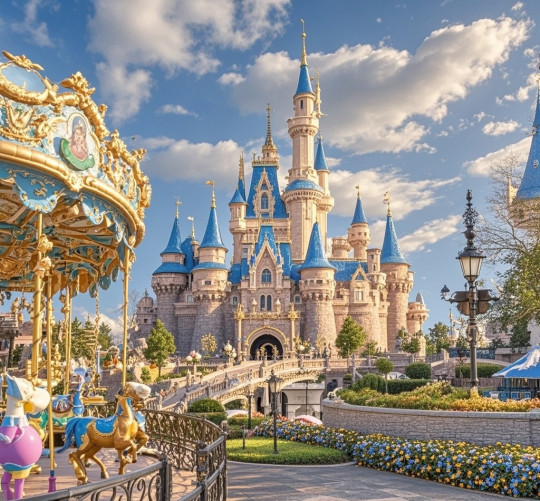


Take a night walk along the west bank of the Huangpu River or take a night cruise to admire the stunning city lights of The Bund.
Climb up iconic skyscrapers such as the Shanghai Tower or the Oriental Pearl TV Tower for a panoramic view of the city.
Visit the Shanghai Museum in Huangpu to learn about ancient Chinese art and history. The museum has a large collection of exquisite bronzes, ceramics, paintings and other cultural relics.
Explore the French Concession area to experience local life and uncover hidden historical treasures.
Explore the world of science at the Shanghai Science and Technology Museum, which is especially suitable for learning and entertainment with children.
Visit City God Temple, in addition to Yu Garden, the surrounding City God Temple is also a popular place for tourists, where there are many traditional arts and crafts shops and food stalls.
Experience the nightlife of Xintiandi and enjoy a night out in Shanghai at the bars and clubs in the area.
Experience the alley culture of old Shanghai in Tianzifang. This is an old alley converted into an art and shopping area, full of literary atmosphere.
Visit Disneyland for a family-friendly trip and a day of theme park fun.
Go to the shopping paradise - Nanjing Road, where you can choose from a variety of products.
Taste the authentic Shanghai food, such as Xiaolongbao, Sheng Jian bao, crab bean curd, etc., to feel the food culture of Shanghai.
Walk along the Suzhou River, where the renovation shows the renewal and development of Shanghai. There are art installations and leisure Spaces along the river.
Watch a Peking Opera or Yue Opera performance and feel the charm of Chinese opera in a traditional theater.
Ride the maglev train, the world's fastest commercially operated train, from Pudong Airport to the city in just a few minutes.
Visit the Shanghai Grand Theatre in People's Square, a modern building that is one of Shanghai's iconic cultural facilities and regularly hosts world-class shows and concerts.
Visit Xujiahui, one of Shanghai's commercial centers, which is home not only to modern shopping malls, but also to historic Catholic churches and museums.
Visit the Expo site. Although the Expo has ended, many national pavilions have been converted into museums and exhibition halls and are still worth seeing.
Visit the Shanghai Ocean Aquarium: Located in Lujiazui, it displays Marine life from all over the world and is especially suitable for families.
Take a day trip to Zhujiajiao, a water town near Shanghai, to admire its canals, ancient Bridges and classical architecture.
Ride or walk around Chongming Island to enjoy the natural scenery and get away from the hustle and bustle of the city.
#adventure#architecture#china#landscape#shanghai#travel#city#photography#trip#guide#travelblr#travelcore#travel inspiration#travel aesthetic#traveling#photographer#artists on tumblr
2 notes
·
View notes
Text
Kyoto Travel Guide: Unveiling the Timeless Charms of Japan's Cultural Heart

Kyoto, a city steeped in history and cultural richness, beckons travelers from around the world to embark on a captivating journey through time. Nestled amidst lush mountains and picturesque landscapes, Kyoto preserves the essence of traditional Japan like no other city. With its awe-inspiring temples, enchanting gardens, and captivating geisha culture, Kyoto offers a truly immersive experience that unveils the country's profound cultural heritage. Join us as we explore the must-visit destinations and hidden gems of this extraordinary city.
Timeless Temples and Spiritual Splendor
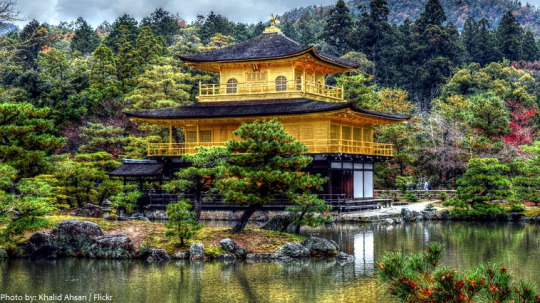
Kyoto boasts a wealth of ancient temples, each with its own unique allure. The iconic Kinkaku-ji (Golden Pavilion) dazzles with its shimmering gold exterior reflected in the surrounding pond, while the serene Kiyomizu-dera Temple offers breathtaking panoramic views of the city from its wooden terrace. Visit the tranquil Ryoan-ji Temple and contemplate the minimalist beauty of its famous Zen rock garden. Explore the exquisite gardens and vibrant red torii gates of Fushimi Inari Taisha, an emblematic Shinto shrine.
Traditional Neighborhoods and Geisha Culture
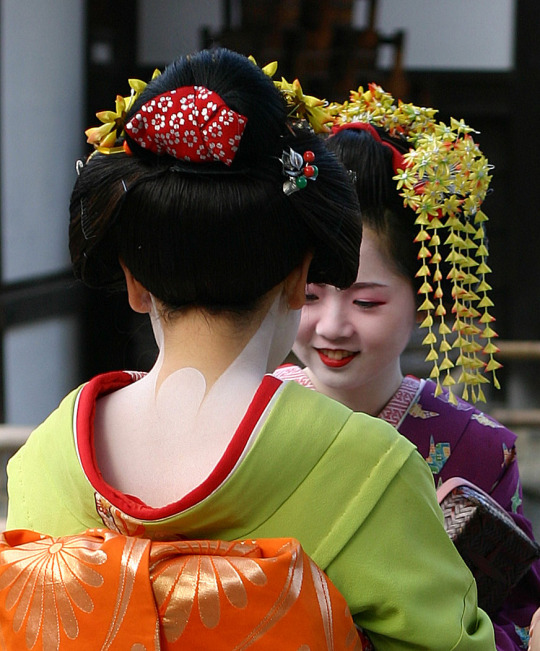
Wander through Kyoto's atmospheric traditional neighborhoods, such as Gion and Pontocho, where the spirit of old Japan thrives. Keep an eye out for elegantly dressed geisha or apprentice geisha known as maiko gracefully gliding along the streets. Immerse yourself in the enchanting world of tea ceremonies, traditional music, and dance performances. Visit the Gion Corner for an insightful cultural show or indulge in a memorable meal at a traditional ryotei (Japanese restaurant).
Enchanting Gardens and Tranquil Retreats

Kyoto's meticulously designed gardens offer a peaceful escape from the bustling city. Explore the sublime beauty of the Arashiyama Bamboo Grove, where towering bamboo stalks create a mesmerizing atmosphere. Stroll through the stunning gardens of Katsura Imperial Villa or experience the harmony of nature at the exquisite Saiho-ji Temple, also known as the Moss Temple. Admire the seasonal beauty of cherry blossoms in Maruyama Park or the vibrant hues of maple leaves in the autumn foliage.
Cultural Heritage and Museums
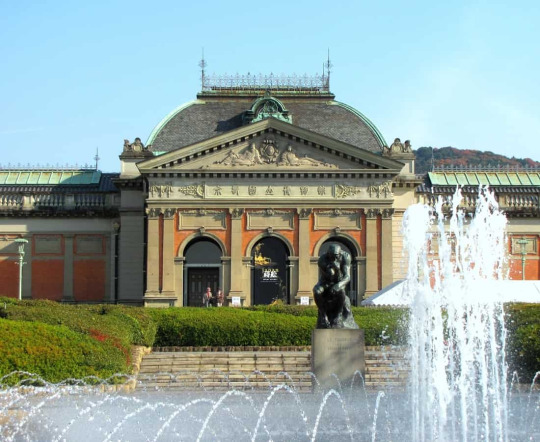
Delve deeper into Kyoto's cultural heritage by visiting its fascinating museums and art galleries. The Kyoto National Museum houses an extensive collection of Japanese art and artifacts, including exquisite Buddhist sculptures and delicate ceramics. Gain insight into traditional Japanese craftsmanship at the Kyoto Museum of Traditional Crafts or explore the intriguing history of manga at the Kyoto International Manga Museum. Discover the captivating world of Noh theater at the Kanze Noh Theater or witness a mesmerizing Kabuki performance at the Minamiza Theatre.
Delightful Culinary Experiences

Kyoto's culinary scene is a feast for the senses, offering a diverse array of traditional delicacies. Indulge in kaiseki, a multi-course fine dining experience that showcases the essence of Kyoto's seasonal ingredients. Savor the exquisite flavors of matcha (powdered green tea) and wagashi (traditional Japanese sweets) at a traditional tea house. Explore Nishiki Market and sample an array of local delicacies, from fresh seafood to delectable street food. Don't forget to try Kyoto's famous yudofu (tofu hot pot) for a truly authentic taste of the city.
youtube
Kyoto, with its timeless temples, captivating geisha culture, serene gardens, and rich cultural heritage, offers an unforgettable journey into the heart of Japan's traditions. Whether you're exploring ancient temples, immersing yourself in the vibrant streets of Gion, or savoring the delicate flavors of Kyoto's cuisine, the city's essence will envelop you in its enchantment. So, embrace the spirit of Kyoto and allow yourself to be transported to a world where past and present harmoniously converge, leaving you with cherished memories that will last a lifetime.
#cheap tickets#tourism#flight tickets#travel stories#traveling#cheap travel#travel tips#cheap flights#travel#youtube#japan#Youtube
13 notes
·
View notes
Text

QARAQORUM STREET VIEW, 1250s
Qaraqorum (Karakorum, Khara Khorum) is famous as the capital of the Mongol Empire and housing the court of the Great Khans, but the textual sources and archaeological study also demonstrate its important as a regional production centre.
The dense settlement layer, particular along the central street and main intersection within the city, shows extensive evidence for wide ranging crafts production, such as glass working, gem and precious stone working, bone carving, processing of birch bark, with furnaces for metal working and kilns for ceramics located in the immediate vicinity of the city. Gold bracelets and the moulds for them and other items have been found in the workshops; remains of iron fragments (bars, wheels caps, even a plough) testify to other activities produced in the city, and for local agriculture. In the written record, we see Khans from Ögedei to Töghön-Temür sending craftsmen and labourers from China to Qaraqorum to expand agriculture, construct palaces and temples, repair existing structures or otherwise support the local economy. This is reflected archaeologically, as the city shows possibly six phases of building and rebuilding from the 13th century until late in the 14th.
In this image you can see a smith's shop, with various Chinese, nomads and even an Alan taking part in activities here. In the background you can see the city's large Buddhist temple complex, the “Pavilion of the Rising Yuan." Begun under Ögedei (but not completed until Möngke's reign, and extensively rebuilt under Töghön-Temür), this huge structure was as high as 90 metres, according to an inscription found on site! Though estimates based on its foundation suggest a slightly more modest structure up to 38 metres high.
You can learn more about Qaraqorum's role in Mongolia's production networks in my latest video on nomadic blacksmithing:
youtube
19 notes
·
View notes
Text
Burrowing, Burrowing, Burrowing - Part One - an Edmund Golden Age Fic
Maithas Bristlebrow rubs his hand down his face and wishes, very fervently, that he was dead. "Tell me again," he says evenly.
The two dwarflings, holding hands and trembling in the face of their fearless leader's reaction, press together. Someone - possibly them - has braided their beards together, so every time one of them moves the other one wobbles and they both have to screech and windmill their arms to stay up straight. "Um," says one.
"It's the burrow," says another.
They both look at each other. Neither of them are old enough to remember last year, never mind before it was winter; to them, this spring is more terrifying than anything else they know. "It flooded," says the first one timidly.
Maithas buries his head in his hands and bites down hard on the meat of his thumb.
It doesn't work.
He's still screaming.
In the aftermath of the White Witch's death, the sudden restoration of Spring leads to some unexpected issues. When the Bristlebrow burrow floods, Maithas Bristlebrow - now Chief due to the death of his brother in the final battle - reaches out to his new monarchs for aid. King Edmund the Just is quick to respond.
read on ao3
The days after the coronation are exhausting; Edmund has never felt more alive.
For one thing, Cair Paravel is mostly in ruins around them. The four Pevensies sleep, therefore, underneath their regal cloaks on the floor in front of the thrones, using their arms and each other for pillows, and wearing and wearing again the clothes Aslan gave them to be crowned in. The party attendees have slept off the wine and wandered (or run) back home, for the most part; Oreius, who Edmund had come to see as part of the furniture, has returned to the remnants of the camp at the Stone Table, giving no word of return. Maybe he won't. Maybe he was a winter general, and now Spring has come he has no intention of doing anything but... whatever it is centaurs do, in their spare time.
Edmund wanders outside onto the first pavilion. His shoes are hurting him. They're uncomfortable Sunday shoes, because he'd been saving his best boots for exploring the woods in the Professor's country, back a hundred years ago (a week? two?) before he came here. Now his other hurts have gone, his shoes are back to being his primary worry, and worry he does; what if there are no shoemakers in Narnia? What if none of them want to make him any shoes?
Inside Cair Paravel, Lucy and Susan are exploring what remains of the basements. Peter is down on the beach, poking into caves, having decided that there must be smugglers somewhere. Edmund kicks listlessly at the grass. Do the other three feel as he does? They walk with a lot more purpose, even Lucy. She's found a leather belt for herself, and has looped the little vial into a free hook, draping it over her waist. It sloshes when she walks.
Edmund does not like feeling sorry for himself.
The pavilion is a pretty place. Maybe once it was roofed, but he suspects not; the tiled floor has mossed and grassed over, and the pillars are blue with salt from the sea and general neglect, but it's still a place someone loved, once.
"Oh, bally it all," Edmund mutters, kicking off his shoes. The knots have swollen with river-water, and are now impossible to unpick; he tosses them into the long grass on the other side of the pavilion and then gets down to his hands and knees, beginning at one corner, wresting thick moss and wildflower stems from between the tiles, pulling them free of the ceramics and throwing them the same way as the shoes.
It's a picture!
Tasked now, Edmund works with a frenzy for hours. Certainly long enough for the sun to rise to an apex in the watery blue sky, and set again - begin setting - with the sort of premature joy a Springtime sun feels, as though it hasn't realised yet that winter is over.
It's a picture!
When dusk is well and truly upon them, and the voices of his siblings are chattering in the Throne Room again, Edmund stands. He brushes his earthy palms against his thighs. He'll have to get up high, to properly see what the picture is.
Perhaps it's a bad idea, but he doesn't put his shoes on. He heads right for one of the curly apple trees on the edge of the pavilion, an old thing long beyond flowering, and clambers up.
"Pretty, that," says the magpie on the branch beside him, in a conversational sort of voice.
Edmund falls out of the tree.
His head aches, but not as bad as his back, where he's landed flat on a gnarled root. His heart is thundering a horse-race in his chest, and he feels stupid and afraid. "Ow."
The bird in the tree flutters down to the rock beside him, and cocks its head. It's a magpie, but it's definitely a Talking Magpie - Edmund is beginning to recognise the hallmarks, the sheen to the feathers, the size of the animal, the intelligence in the beady eyes. "You one of the yoo-mans, then?" The bird asks, still looking at the pavilion, "Damn odd thing for a yoo-man to do."
"I'm human," Edmund says. He's still lying, looking up at the stars. God, his head throbs.
"You one of the Kings or Queens?"
Edmund nods and instantly regrets it. "Queens are girls," he explains, "Kings are boys. I'm a King."
"How in damnation am I to know whether you're a girl or a boy?" The Magpie scolds him, cackling deep in its throat, "You ain't no pretty bird, so who's to tell?"
"I can't tell with you," Edmund says with considerable injury.
"Well!" The Magpie preens, looking as offended as a bird can get, "Well! That's a fine thing to say to a body, and a body what's your loyal subject and all!"
"Oh." Edmund thinks about that for a second, "Yes. Sorry. That was rude. Sorry."
"Hmph."
After a while, Edmund feels safe enough to sit up; he leans against the trunk of the apple tree, surprised enough to see the Magpie still beside him, perched on a log. "I don't want to climb up again," he confesses to the bird, "Will you... what's the picture?"
The Magpie quirks its head. "It's a pair of yoo-mans," it says, "Looking real fine. Wearing pretty feathers. Got gold and stuff on their heads, and a Pegasus with them."
"A Pegasus?"
"You dunno what a Pegasus is? Hell, maybe you is simple."
Edmund doesn't say anything. He isn't sure what to say.
"'S a flying horse," the Magpie says sullenly, after a few moments, "And I'm Maulkbone. And I'm a boy Magpie, so don't go making no assumptions, you."
"Oh," Edmund turns and grins, unable to help himself, "Maulkbone - it's lovely to meet you - I'm Edmund."
"King Edmund," says Maulkbone with a grin in his beak, "Not Queen Edmund?"
For the first time in several days, Edmund laughs and means it.
Maithas Bristlebrow still wishes he was dead, because being dead - surely, surely - would be less hassle than this.
"We have to camp, Granny," he repeats for the fiftieth time, "Because the burrow is full of water."
Granny Bristlebrow folds her arms over her chest. "I amn't going," she declares, much to the amusement of the various Bristlebrows witness to this argument, "And you amn't gonna make me, Maithas, Chief or no Chief!"
In the hours since the Bristlebrow clan has been flooded out of their burrow, a sort of refugee camp has grown in the forest near the river, higher than the floods can possibly reach. We hope. Dwarves are always prepared and many-layered; a mish-mash of tents made out of jackets, half-tanned leather, trousers, jerkins, shirts, towels, and blankets has become a sort of aboveground burrow, where Bristlebrows of all sizes now sit, feeding babies and sharpening shovels and braiding hair and generally looking about as displaced as Maithas feels. Dwarves are not made for sitting around.
"Granny," he tries again, lowering his voice, "C'mon, please. People're starting to watch."
Granny Bristlebrow just cackles, her walking stick brandished like a weapon. "I'm staying on this bank until Winter comes back or you dig me a new burrow," she says. "Yessir, Chief Bristlebrow, Sir!"
Maithas closes his eyes and takes a deep breath. His ribs are still bruised. "Granny," he says, "Until you move, we can't start digging you a new burrow."
Some murmurs of admiration among the gathered Bristlebrows at this new piece of diplomacy.
Granny Bristlebrow nods her head in acknowledgement, like a master chess player impressed at a reckless move from a rookie. "Fine, then," she says, and holds out her hand, "You can carry me up the hill if you truly must, but I ain't moving any further than that!"
Thankfully, Granny Bristlebrow weighs about as much as a sack of spuds, and Maithas is strong even for a dwarf. She still beats the backs of his knees with her stick as he walks, but that's just to keep him on his toes. "I'll kill her!" Granny says cheerfully, swinging with every step Maithas takes, "She'll die!"
"Pretty sure she died already, Granny," Maithas says, depositing his grandmother at the mouth of one of the first tents. The Bristlebrows have dispersed again, back to their pasttimes, Maithas's entertainment having left them, "I should know. I seen it, didn't I?"
She pats him on the head with her free hand. "Everyone's seen it."
"Sure, but I was there."
"I know, son," Granny Bristlebrow keeps patting him. It makes Maithas feel very young, and very un-Chiefly, "Was it that brave Son of Adam what did it?"
"No," Maithas admits, "It was..." And he finds he can't remember. He'd been Captain of the Black Dwarf team, a group of about twenty Bristlebrows, Blackbanes, Beardbraids, Ballangers, and Bluebanders; by the time the news spread, Maithas had still been wrestling with a particularly savage Red Dwarf from the other side (hence the bruised ribs, he remembers with a wince).
Granny pats him on the cheek again.
When Maithas stands, knees cracking, and surveys the hill, his heart sinks. There are maybe three hundred Bristlebrows currently lying in the woods - the burrow that flooded was the central campment, and that's not counting the cousins, uncles, aunts, siblings and distant relations still returning through Narnia. In a week, he will have five hundred dwarves to house, and nothing but watery soil to house them in, should they miraculously learn how to breathe underwater.
He wanders up the hill, lest Granny start giving him advice again. He's been Chief for - Aslan's Mane, how long ago was the battle? It can't be a week, can it? - and already he can feel the grey hairs in his beard.
"Caw! Caw!"
Stopping just below a tree, an Aunt of his - Charia Bristlebrow - and her fourteen children stirring a stew pot, Maithas squints up. The voice is familiar. "Maulky?"
Sure enough there's a Talking Magpie in the tree, although when Maithas meets his eyes the bird flutters down onto his shoulder. One of Charia's children, a little dwarfling not much older than a year, giggles.
"Pretty pickle you're in here, Bristlebrow," Maulkbone Magpie says. He chucks, an instinctive noise in the back of his throat, and starts to preen his feathers.
Maithas slumps. "I know," he says. Charia very kindly turns the children back to the stew, to let him have his breakdown in peace. "Ye gods, Maulky, what am I going to do? My burrow's flooded, and Matthein is - Matthein is-"
Maulky pecks fondly at Maithas's ear. "Sorry," he coos, "Sorry-sorry-sorry. Pretty pickle you're in here, all the same."
The dwarves up the hill a bit have started singing a mournful gold chant. So many men and women have not returned; the Bristlebrow clan is either very very young, dwarflings without hardly any beard, or very very old, hobbling around on two sticks. The very first thing Maithas has done, on becoming Chief, is make the whole bloody lot of them homeless.
Ye Gods.
"I know summat that could help," says Maulky thoughtfully. Well. Pretend-thoughtfully. The sort of thoughtful he says, sometimes, when he's scheming.
Maithas both hands on his eyes and presses until he sees stars. "What? What could possibly help?"
Magpies can't grin, but Maulky does a damn good approximation of one. "You ever make it to that funny coronation up the country, in the end?"
#narnia#narnia fic#edmund pevensie#edmund pevensie fic#golden age of narnia#my writing#softlyblues#burrowing burrowing burrowing
11 notes
·
View notes
